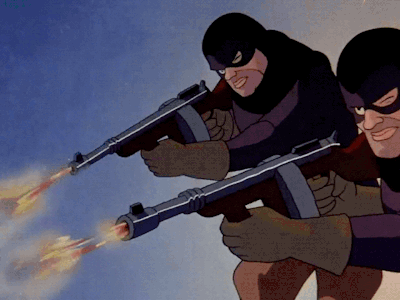
On the night of June 2, 1932, a robber broke into a second hand clothing store in Cleveland, Ohio to make an easy score. The owner, a 60-year-old Jewish immigrant from Lithuania named Mitchell Siegel, happened to be present when the thief made his entrance. Though the police report later said gunshots were heard, Siegel’s family and the coroner, however, would claim he died of a heart attack.
This tragedy is the type of petty crime all too prevalent in our world, and describing one which took place so long ago would seem of little consequence to anyone not part of the late Mr. Siegel’s immediate family and friends; at the time of his death, however, Mr. Siegel left behind a 17-year-old son, Jerry, a writer who had recently befriended a young artist named Joe Shuster. Within six years, these two young men would create, in the stellar new medium of the day, comic strips, an all-powerful (and bulletproof) champion of justice, sent to Earth from another world to guide and protect us mere mortals.

If ever there was a purer example of the wish fulfillment offered by comic book superheroes, I cannot think of it.
Most of the classic comic heroes have origin tales steeped in tragedy, but the fact that Superman, the original superhero, was likely created out of a son’s response to a senseless act, is unbearably poignant. Author Brad Meltzer, who revealed this amazing story to USA Today in 2008, later added, “Superman came not out of our strength but out of our vulnerability.”
Indeed, it is out of our collective vulnerabilities that superheroes make their biggest mark, even in these latter days of superhero cinema when the sheer volume of comic book films and television shows threaten apathy as much as a sense of wonder; there is a school of thought that the tableau vivant quality of comics make them inherently uncinematic, but, whether that’s true or not, it is incumbent on any filmmaker bringing these characters/stories to life that they bring more than spectacle and snappy one-liners.
Filmmaker and comic writer Kevin Smith was correct when he revealed in the documentary COMIC BOOK SUPERHEROES UNMASKED that even the finest big screen superhero epics do not allow us to internalize those characters thoughts and feelings as well as the printed page does.
While lacking in the internal landscape that Smith mentions, the Fleischer Superman shorts of the 1940s remain arguably the high water mark for comic book adaptations (animation is truly the best medium for superheroes) because they deliver purely visual adventures with no one-liners, no brooding angst, no camp, just pure escapist Technicolor fun.
“The Superman cartoon shorts by Max Fleischer are in a league of their own in terms of production quality, style and execution,” Michael French of Retroblasting.com shared with me. “A lifelong fan of these cartoons myself, I consider them some of the finest Superman adaptations ever made, alongside Christopher Reeve’s 1978 film.”
Quite so.
Superman may have been the world’s first comic strip superhero, but he was not the first to make it to the silver screen; Fawcett Publications’ rival hero Captain Marvel took that distinction when Republic Pictures brought him to life in the 12 chapter serial THE ADVENTURES OF CAPTAIN MARVEL in 1941. As historian Jerry Beck outlined on the serial’s Blu-ray, Republic had originally tried optioning the film rights to the Man of Steel, but they couldn’t agree with National Allied Comics (later D.C. Comics) on how to adapt Superman for the big screen.
On the rebound, a deal was struck with Paramount Pictures to produce a series of animated Superman shorts, which Paramount offered to Max & Dave Fleischer to create. The brothers, who’d had success with the Betty Boop and Popeye cartoons, initially balked at the offer because they knew the challenge of doing the phenomenally popular superhero justice, so they devised a budget for each short that was so high that they were sure the studio would drop it. Instead, Paramount gave the go-ahead.
To bring the Man of Steel to life, the Fleischers employed a tried a true technique which Max Fleischer, an artist and techno nerd very similar to Walt Disney, patented in 1917 in the Neolithic period of motion picture animation – rotoscoping.

Rotoscoping involves filming actors in live-action, then tracing over the footage frame by frame on an animation stand to give a more life-like quality to the drawn figures. Although the medium has changed from hand-drawn cels to CG, rotoscoping has lived on in films such as A SCANNER DARKLY and WAKING LIFE; it has often unfortunately been used as a simple animation shortcut with less than stellar results, as in the 1978 Ralph Bakshi LORD OF THE RINGS full-length animated film.

Michael French summed up the differences between the Fleischers and their imitators perfectly: “The rotoscoping within these shorts is not the corner-cutting roto’ done to background characters in Bakshi’s Lord of the Rings. Rather, it is in the service of fully-realized animated characters throughout. It is little wonder that these shorts were some of the most expensive animation per minute ever made.”
The time, care, and imagination exercised by the Fleischer Studios speak for themselves:

Beyond mere technical prowess, the Fleischer team also brought an economy of storytelling that remains an enviable model for visual storytelling; Howard Hawks’ famous rule for great moviemaking (“3 good scenes, no bad scenes”) becomes infinitely more challenging when creating a 7-9 minute short, but by pumping up the visual and minimizing dialogue whenever possible, the Fleischers succeeded superbly.
Take the opening of BILLION DOLLAR LIMITED. We start with a newspaper headline declaring that a train loaded with a huge shipment of gold is about to be escorted to the U.S. Mint; a shadow of an armed policeman falls across the paper, and we cut to a wider angle of the armed guards looking on as the gold is loaded onboard. In less than 30 seconds, the entire story is set up perfectly.
Using shadows in animation can be a cost effective shortcut around animating a character’s entire face and rustling clothes, but it’s done so artfully throughout these cartoons, from Lois Lane typing away in her office at night, to Clark Kent becoming his alter ego in silhouette, that we never feel it’s simple penny pinching.
Despite their strong visuals, the influence of radio is also clearly apparent on these shorts as well. In the early scenes of the studio’s first Superman short, we’re given the background of the doomed planet Krypton; rather than showing any glimpses of the world itself or of Superman’s father safely placing him in a rocket ship to spare him, we see simply the green planet itself as the narrator boldly and dramatically informs us what’s happening, and our imaginations take care of the rest.
Music was a key factor in not just the atmosphere but also the storytelling of radio dramas (Orson Welles’ Mercury Theatre on the Air owed a vast debt to Bernard Herrmann’s ominous and thundering chords, especially their production of DRACULA), and Sammy Timberg’s music for the Superman series is equally indispensable.
Very often, music that closely mirrors/compliments the onscreen action is derisively referred to as “Mickey Mousing” because of how Disney utilized music in their early Mickey Mouse and SILLY SYMPHONY shorts, but Timberg’s music not only gives these films an energy that’s irreplaceable (try watching them with the sound off), but the music even takes the place of sound effects at times, such as in the initial short when Superman gets struck down by the scientist’s death ray; Timberg’s horns fill in for what could’ve been costly sound effects while also serving as percussive music in its own right. It’s also interesting how he orchestrates the name “Superman” so often in these shorts, especially in the main titles, which is a theatrical touch John Williams echoed in his masterful score for the 1978 Superman, and James Bernard even did the same for Count Dracula in Hammer’s 1958 HORROR OF DRACULA and some of its sequels.
As forward thinking as many of these technics may be, the Fleischers most assuredly were inspired by what preceded them. The mad scientist in the premiere cartoon (I’ve seen it titled either THE MAD SCIENTIST or just SUPERMAN) is clearly influenced by Whale’s FRANKENSTEIN. The crazed doctor is dressed in a surgeon’s smock much like Colin Clive, the scientist’s tower is incredibly reminiscent of Dr. Frankenstein’s watchtower, and his electrical lab is one Frankenstein would’ve been envious of.

THE ARCTIC GIANT, in which Superman fights a newly thawed prehistoric beast in Metropolis, may well have been influenced by KING KONG, but also manages to eerily predict GODZILLA.
After completing the first nine Superman shorts, Max Fleischer and his brother Dave dissolved their partnership over irreconcilable creative differences, and the Fleischer Studios were reshuffled into Famous Studios, where the team completed another eight shorts. They are still as innovative as the earlier shorts, the Famous Studios’ batch took on more wartime tales than fantasy, filled with the appalling racism that populated many films and comics of the time did, the other such reprehensible marriage being the 1943 BATMAN serial from Columbia.
Superman, and superheroes, may have come from our own vulnerabilities, but the Fleischers, in a brief, almost throwaway moment in each of these shorts, perfectly sum up the key to the superhero myth with a simple dissolve from Superman to Clark Kent – there’s someone unnoticed but extraordinary inside all of us.

For more background on these classic shorts, the Warner Bros. featurette “First Flight” is an invaluable resource.
For all great things nostalgic, visit http://www.retroblasting.com
Copyright (2018) by Eric Peeper
